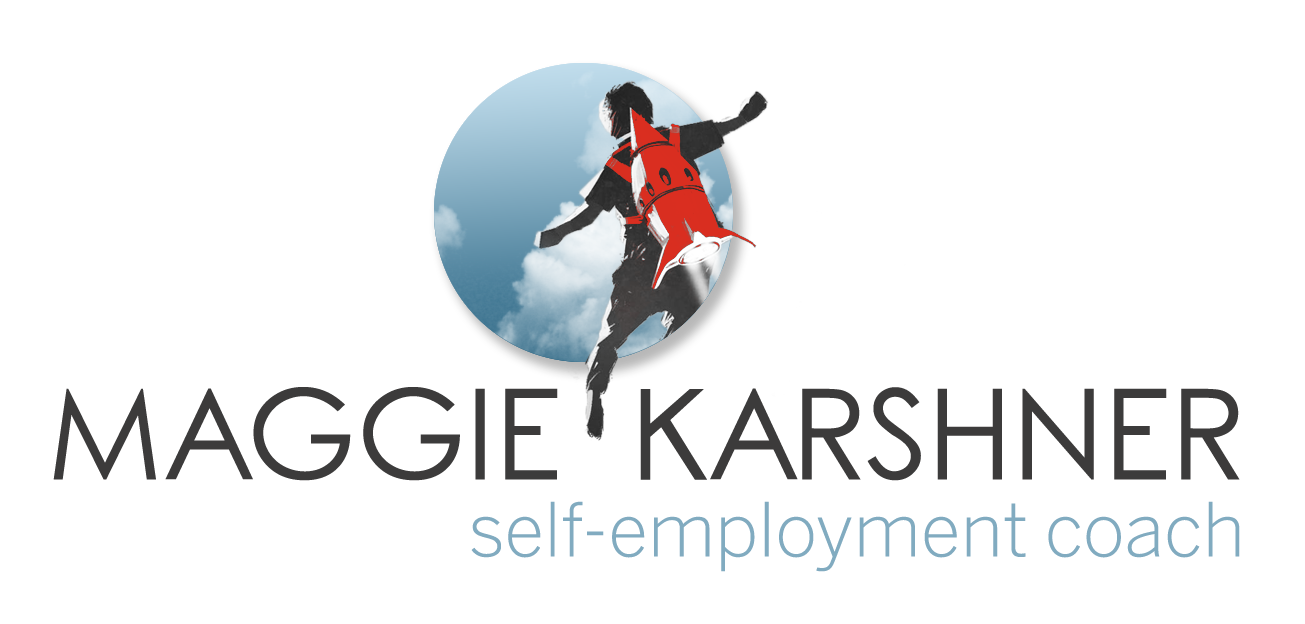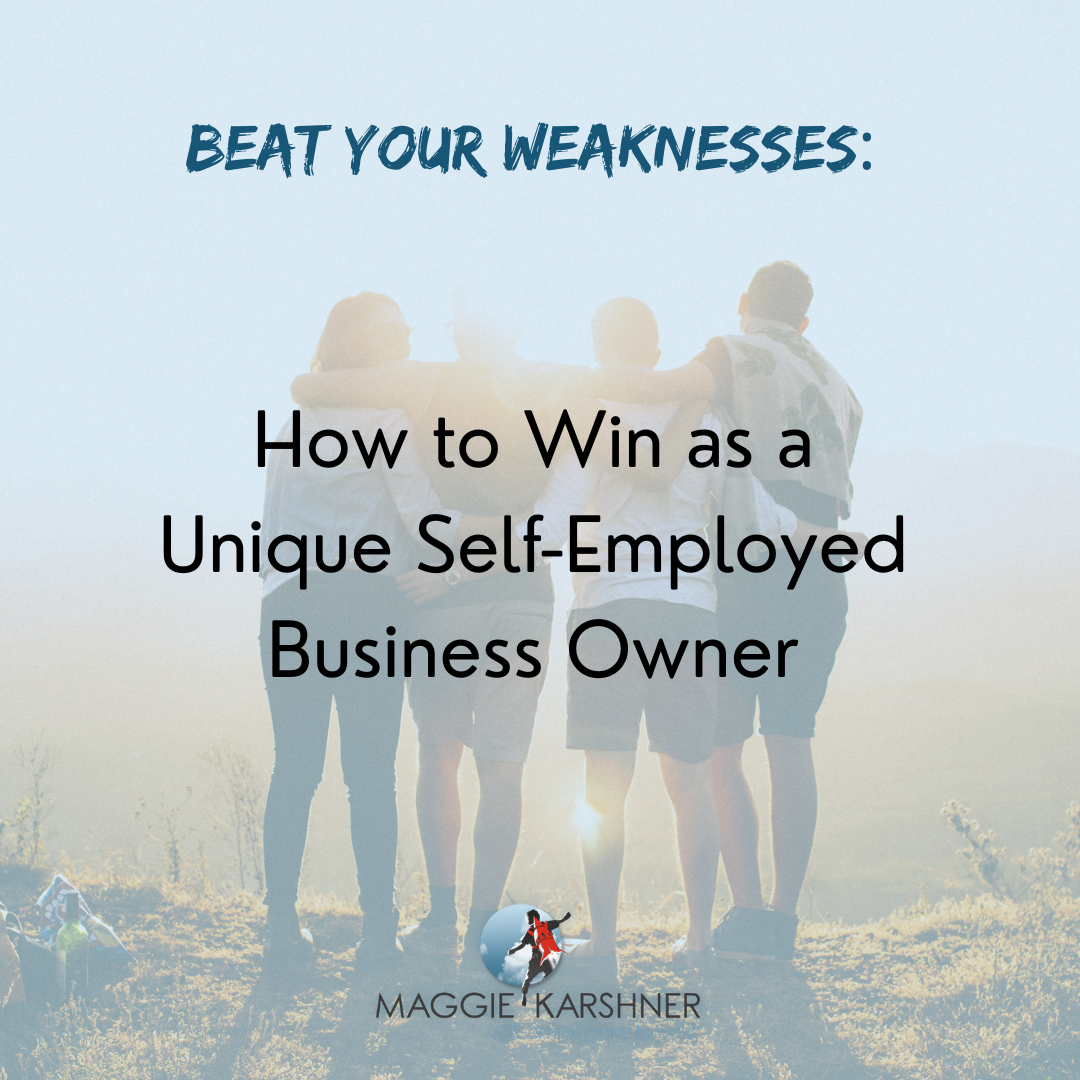Beat Your Weaknesses: How to Win as a Unique Self-Employed Business Owner
/I want to talk about some scary stuff. Today, we're talking about a nugget of insecurities that most people have in at least some shape or form. Yes, it is hard to face your fears and insecurities. But I have faith in you! You are reading this in a (hopefully) safe space, and you need not take any action until you are ready! Insecurities will come up as you are launching a business, so it's good to get familiar with them now. When you know about them, it's less likely that they'll derail you. And it's never too late to face them.
When launching a business, we're putting ourselves out there in a way that most people never do. We're putting ourselves in a situation laden with competition. The stakes might feel higher than any other situation we've found ourselves in. And yet we must persist. Comparing ourselves to others is literally part of business planning. So, while you can avoid it, it's not recommended. Insecurities are difficult to face, and they are surmountable challenges. I'm going to get into some key reframes.
This is the third in my series on Self-Employed Business Plans. No, traditional business plans don't ask you to face your insecurities. (Maybe they'd be more helpful if they did.) As a self-employed business owner you are your business. And a key "weakness" in the business is your personal weaknesses: insecurities. All business plans understand that we can't eliminate weaknesses. Business plans ask that we are aware of our weaknesses and have a plan to mitigate them. For personal insecurities, acknowledging that they exist is a huge first step. Next, we can mitigate these insecurities by using the re-frames I offer in this article. But first, a nod to the traditional business plan. The third section is usually the "Products and Services" section.
Traditional Business Plan: Products and Services
The third section of a business plan focuses on the business's products and/or services. In a traditional business plan, the writer must assume the reader is unfamiliar with the product, service, and industry. This section needs to cover all the basics of your business's offer. What it is, how much it costs, and any fee or leasing structures you may offer. It also needs to speak to the goals of an investor or lender. Namely, what sets your product/service apart from the competition. It's tempting to only highlight the positive, but everything comes with a trade-off. This is also the section to be frank about the disadvantages of your offering. If the reader is only told the good stuff, they might feel it's too good to be true and, hence, trust you less.
Self-Employed Business Plan: Products and Services
For self-employed businesses, it's also important to know what you're offering. But we focus on what it means to the customer rather than a lender. The customer-facing information is in the Marketing Section of a traditional business plan. You'll also want to know what you're pricing things at. Though you won't be offering any complicated leasing or financing around it. I'm going to discuss how to price when we get to the fifth section of the business plan. (That's the Financial Section.)
The thing we're going to focus on is the competitive advantages and disadvantages. It's easy for insecurity to tell us we have no significant competitive advantages. Self-employed businesses rarely innovate on their offering. This means there are a bunch of other people offering very similar things in the same industry. For example, I'm a business coach. I'm in the same industry as Alexis Fedor, Tony Robbins, Allison Dunn, Babs Smith, and Dan Sullivan. These folks do much the same thing I do, and I'm in competition with them, right? Let's look at this a bit closer.
Competitive
I could look at the offerings of one or many other coaches and believe that they've got it covered. I have nothing to add to the conversation and I couldn't do anything they're not already doing. And in some ways, that would be true. However, none of them are me. They'll never frame things the way I do. They'll never say it just the way I do. That means you, dear reader, will connect to the same information differently. You are consuming my content despite (or maybe because of) what those big names offer.
This is likely true for you in your own industry. You're not the only person offering what you offer. And you're the only YOU. No matter how much you look up to your teachers or prominent figures in your industry, they cannot be you. Your products are similar to others, but they cannot be identical to what you produce. Customers will connect with your service or your products because its all unique to you.
Your service or product will connect with your clients differently. Plus, your marketing will also connect with them differently. I'm not in competition with Tony Robbins because my marketing speaks in a different way. (If it's even speaking to the same people at all!) There is no one solution that's going to work for everyone. This was the Prego pasta sauce innovation by Howard Moskowitz, immortalized in a Malcolm Gladwell TED Talk. In this story, we realize that not everyone is going to like the same singular pasta sauce the best. In the same way different people are going to connect differently with different business owners. You don't need to contrive a differentiator, you just need to be you. In the words of Dolly Parton, "Find out who you are and do it on purpose."
Competition is also a wild notion in super small-scale businesses like ours. You don't need to capture a market segment. You can't. There aren't enough hours in the day! Don't believe me? Think it through. If you're making a product, how long does it take to make a batch of your product? Imagine the full capacity of that process; about how much would you produce? For consultants, how many contracts can you manage at once, and how many billable hours are you willing to commit to in a typical week? For service providers, how many clients can you serve in a week?
I'll use myself as an example again: I can hold a maximum of 20 sessions in a week. If every single slot is full with a large small group, that's 120 people per week or 1,560 per year. (This is a max capacity I don't hope to experience. I'm very pleased with the couple dozen new clients each year.) But even if every one of those group sessions was one-and-done, that's a max of 6,240 people in a year. We're talking about less than the population of a city block. That's the number of people a shopping center wants to see during their peak hours on one day. And that's the upper limit of how many people I could serve in a year. The scale of our businesses is SO much smaller than the rest of the business world. You're not Coca-Cola and Pepsi battling it out. You need a postage stamp-sized portion of the market. You do not need to be "competitive" that is silly. You just need to take up the space you need to take up.
To recap: You're not in competition with anyone else because only you can be you. Only you are going after your precise market segment in the precise way that you're doing it. And competition is really not a big deal because you actually don't need that many clients!
Advantages and Disadvantages
As we examine competitive advantages and disadvantages, let's not throw the baby out with the bathwater. The notion of competition might be laughable in self-employment but not the rest of that. Understanding the advantages and disadvantages of your offering is emotionally heavy work. And it's super valuable to do this work! Every choice we make in crafting your business has a trade-off. There's not a right and wrong answer, there are pros and cons, advantages and disadvantages.
I often notice people trying to sweeten the deal with affordable rates or discounts. They try to be immediately available to clients. Or they promise fast turnaround times. These are things we see many businesses engage in, so clearly, this is how things are done, right?
No one can be the fastest, the cheapest, and the best all at once. Most consumers can identify that as a scam from a mile away. Consumers expect there will be tradeoffs, so claiming there are none sounds like a lie. When it comes down to it, a business can only optimize around one of three things: price, convenience, or quality. You need to be clear about what you're optimizing around. If you're not, your customer's con artist alarm will start blaring.
Nearly ALL self-employed businesses optimize around the same thing. Do you know what it is? I tipped my hand in the earlier part of this article... Self-employed businesses optimize around quality. e.g., the unique thing about you. Quality doesn't have to be the "best," but it is something unique. Your customers will appreciate the unique stuff about you. This is your key advantage.
The disadvantage of this is that we cannot optimize around price or convenience. We will never be the cheapest option. (So, do we even need to bother with discounts?) We will never be the most convenient, immediate solution. If we lead with that, then we're setting unreasonable expectations for our clients. We need to celebrate our quality, and that might come with delays or longer timelines. Present your offerings with honesty and integrity. Clients will appreciate you for it.
Boldly Celebrate Your Weaknesses
Understanding your product or service is all about being laser-focused. It's having boldness. The boldness to celebrate your strengths and the boldness to celebrate your weaknesses. The impulse to hide our vulnerability is natural, especially in a competitive environment. The wise among us understand that vulnerability is a strength and competition is a lie. We have abundance, not scarcity. Our transparency and camaraderie is one of our biggest assets. Approaching self-employment in this way makes the journey more easeful and joyous.




